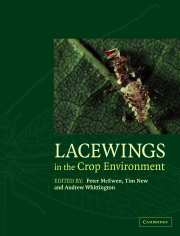Book contents
- Frontmatter
- Contents
- List of contributors
- Preface
- PART 1 Lacewing systematics and ecology
- PART 2 Lacewings in crops
- Introduction to Part 2
- CHAPTER 8 Lacewings in field crops
- CHAPTER 9 Lacewings in fruit and nut crops
- CHAPTER 10 Lacewings in vegetables, forests, and other crops
- PART 3 Principles
- PART 4 Case studies
- PART 5 Conclusion
- Taxonomic index
- General index
CHAPTER 8 - Lacewings in field crops
Published online by Cambridge University Press: 04 May 2010
- Frontmatter
- Contents
- List of contributors
- Preface
- PART 1 Lacewing systematics and ecology
- PART 2 Lacewings in crops
- Introduction to Part 2
- CHAPTER 8 Lacewings in field crops
- CHAPTER 9 Lacewings in fruit and nut crops
- CHAPTER 10 Lacewings in vegetables, forests, and other crops
- PART 3 Principles
- PART 4 Case studies
- PART 5 Conclusion
- Taxonomic index
- General index
Summary
INTRODUCTION
The best known aphidophagous predators in field crops are syrphid flies, coccinellid beetles, and chrysopid lacewings. Lacewings are likely to occur on almost all field crops all over the world. Where aphids occur on field crops, lacewings will also occur. There is one notable exception: there are no Chrysopidae on field crops in New Zealand, and all deliberate importations have been unsuccessful. However, there are some hemerobiid brown lacewings in field crops in New Zealand, mainly introduced from Australia (Wise, 1996).
Most lacewing species, green or brown, are arboreal or live on woody shrubs. Few species develop on field crops, but those species that do can be extremely abundant and widespread. The literature on predatory activity of lacewings in crops is dominated by one single species complex: Chrysoperla carnea. A literature survey (400 BIOSIS and CAB abstracts) of papers published since 1970 on lacewings in field crops indicated that 83% of all contributions refer to C. carnea. The problem with all published work on C. carnea is, that in the light of recent investigations it became clear that C. carnea is in fact a complex of at least 20 sibling species, some of which are at present only distinguishable behaviourally (see Chapter 3, this volume).
THE MAIN LACEWING GENERA PRESENT ON FIELD CROPS
The following genera are prioritised by the number of publications since 1970, with scientific names adapted to the new taxonomy proposed by Brooks & Barnard (1990) and Brooks (1994).
- Type
- Chapter
- Information
- Lacewings in the Crop Environment , pp. 158 - 171Publisher: Cambridge University PressPrint publication year: 2001
- 32
- Cited by



